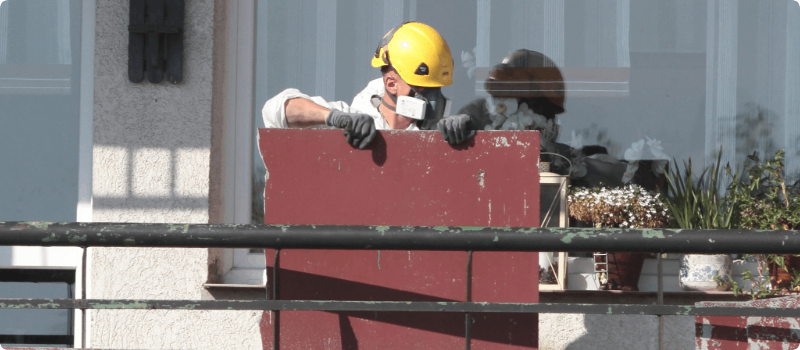What to do if you find asbestos in your house
Updated April 1, 2024 . AmFam Team
If your place was built before 1980, you may have found asbestos in the home — perhaps even by accident. Present in old floor tiles and used to insulate pipes long ago, asbestos can show up in many forms. Depending on the materials used and the builder, asbestos in old homes can be an all-too-common problem. So, how are you to tell if your home has asbestos and what do you do if you find any? That’s where we come in with our primer on how to manage asbestos in your home.

What should you do if you find asbestos in your home?
The first thing you’ll want to do is isolate the area where you suspect asbestos is hiding. Don’t disturb it in any way. And most importantly: don’t attempt to fix the issue yourself. Sweeping up debris can push dangerous asbestos fibers into the air where they can get into the lungs, and that’s to be avoided at all costs. You’re best off contacting a licensed and bonded asbestos abatement group who’ll come out and assess the situation, and advise you on the best action to take.

Identify where the asbestos was found
By understanding where asbestos is commonly found, you can take a careful look around your house and see if you find any problem areas. Although identifying asbestos is best left to the pros, you can explore your home the way they do and look for signs and symptoms.
Is the asbestos friable or non-friable? This is an important term to know, because it helps you to understand how stable the asbestos is. Simply put, if the suspected material is friable, that means it can be easily reduced to a powder by hand when it’s dry. Friable asbestos is more likely to loft measurable levels of asbestos into the air when disturbed. Non-friable is less of a hazard because it’s more stable and less likely to become airborne.
So, where is asbestos found? Here are common places where it may be hiding in plain sight across your home’s building materials:
It’s found in the attic. Used to keep warm air from escaping through the attic, vermiculite can sometimes contain asbestos. Other insulation products in use before 1986 may have some asbestos product in there as well.
It can be within your drywall. Almost all walls constructed before 1986 contain non-friable asbestos, or asbestos in a stable state.
It’s found in pipe insulation. Usually presenting as a thick blanket surrounding a length of pipe, thermal insulation like this is typically quite friable.

Take precautions to avoid asbestos exposure
If you think there’s asbestos in your home, it’s important that you practice asbestos safety from the start. One of the problems with asbestos exposure is that it can take decades for symptoms to emerge. Its microscopic dart-like fibrous crystals penetrate deep into the lungs, sometimes leading to serious respiratory problems. And figuring out exactly how much asbestos is dangerous can be difficult too. Variables like the amount of airborne material and the length of exposure come into play.
Because the dangerous material is often too small to see with the naked eye, you’re best to exit the area and seek an abatement expert’s opinion on the matter. If asbestos is disturbed in your home, get away from the area and inform others to stay away until the issue’s been resolved. Here are other measures you should take:
- Don’t touch the area in question
- Work as passively as possible, careful not to disturb any materials
- Look for signs of tearing, abrasions or water damage
- Keep family and pets away from the area until it’s been contained
- Contact a certified asbestos abatement team in your area
- Consider encapsulating or sealing the affected area of your home temporarily
- Create a plan to have the asbestos professionally removed if necessary

Consider the cost to remove asbestos
The average cost of asbestos removal is around $1900, according to HomeAdvisor, though asbestos removal costs can vary, sometimes by thousands of dollars. Asbestos removal fees are dependent on several factors like the location of the issue in the home and the amount of material to be either sealed or abated in order to make your home safe again. Often, testing happens before and after work is performed to scientifically verify that the risk has been significantly decreased.

Disclose of asbestos before selling your house
Asbestos dangers are often found in older homes. If your home was built before 1986, there’s a good chance that some of the materials currently in use contain asbestos products. Before they were known to be so dangerous, asbestos was considered a great building material. It was used all over the home. But, do you have to disclose of asbestos when selling a home? The answer is tricky. If you know of its presence in your home, you need to make that news known to the buyer, by law. But if you’re not aware of it in your house, you simply claim you don’t know.
Asbestos disclosure statements are official documents and you’ll encounter them during the disclosure phase and at closing — when ownership changes hands. Do home inspections check for asbestos? If the home’s old enough, and the inspector’s doing a thorough job, they may. If a prospective buyer finds asbestos during an inspection, you’ll probably receive an estimate for remediation and abatement. The buyer will either request that a given amount be deducted from the selling price or that monies be escrowed for the purposes of professionally dealing with the asbestos.
If you’re planning on purchasing a home, you’ve got a lot to think about. Check out our first-time homebuyers guide — it can really help you navigate the process and buy with greater confidence. Get in touch with your American Family Insurance agent today and review your homeowners insurance options. You’ll find real peace of mind knowing that your big investments are insured carefully.
This article is for informational purposes only and includes information widely available through different sources. This article does not afford, offer, or guarantee any coverage.

